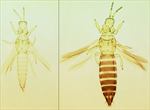
Male & female
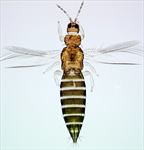
Female

Antenna

Head & thorax
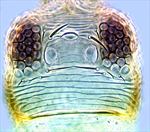
Head
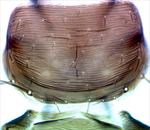
Pronotum
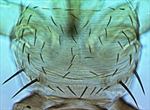
Pronotum
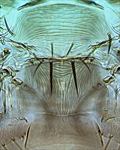
Mesonotum & metanotum
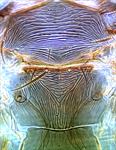
Meso & metanotum
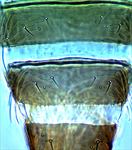
Tergites VII–VIII
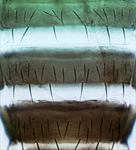
Sternites V–VII

Male sternites

Fore wing clavus

Fore wing
Both sexes fully winged. Body brown, or sometimes bicolored with head and thorax paler than dark abdomen; legs yellowish; antennal segment III yellow; fore wing brown with base paler. Antennae variable, 8- or 7-segmented; III & IV each with a short forked sense cone; segments VII & VIII short. Head wider than long; two pairs of ocellar setae; pair III stout, arising just outside ocellar triangle margins; postocular setae pairs I & III slightly shorter than ocellar setae pair III, pair II very small. Pronotum with 2 pairs of long posteroangular setae; posterior margin with 3 pairs of setae. Mesonotum with lines of sculpture between and around campaniform sensilla near anterior margin. Metanotum with lines of sculpture longitudinal medially, transverse at anterior; median setae arising at anterior margin; campaniform sensilla present. Fore wing first vein with 3 setae on distal half; second vein with about 14 closely set setae; clavus with 5 marginal setae and subapical seta shorter than apical seta. Abdominal tergite II with 4 lateral marginal setae; tergites V–VIII with ctenidia present laterally, on VIII posteromesad to spiracles; tergite VIII with posteromarginal comb complete medially, microtrichia small and irregular, sometimes arising in groups; pleurotergites without discal setae. Sternite II with 2 pairs of marginal setae, 1–4 discal setae; sternites III–VII discal setae varying from 10 to 25, in a regular transverse row.
Male smaller and paler than female; tergite VIII with no marginal comb; sternites III–VII with transverse pore plate anterior to discal setae.
T. hawaiiensis is a member of an extensive Asian group of species (Palmer, 1992). It is very similar to T. florum Schmutz, although in that species the subapical seta on the fore wing clavus is longer than the apical seta. The genus Thrips is the second largest genus in the Thysanoptera, and currently includes, worldwide, about 295 species. All members of the genus lack ocellar setae I on the head, and they all have ctenidia on tergite VIII posteromesad to the spiracles. Other characters, such as number of antennal segments, number of setae on the fore wing veins, and number of discal setae on the sternites are variable between species (Nakahara, 1994; Mound & Masumoto, 2005).
Breeding in the flowers of various plant species, although often associated with Gardenia [Rubiaceae].
This species is widespread across Asia and the Pacific Islands, but it is also found in Jamaica and some southern States of the USA, including California.
THRIPIDAE - THRIPINAE
Thrips hawaiiensis (Morgan)
Euthrips hawaiiensis Morgan, 1913: 3
Thrips sulphurea Schmutz, 1913: 1011
Thrips nigriflava Schmutz, 1913: 1012
Thrips albipes Bagnall, 1914: 25
Physothrips albipes Bagnall, 1916: 401
Physothrips pallipes Bagnall, 1916: 400
Bregmatothrips theifloris Karny, 1921: 66
Thrips versicolor Bagnall, 1926: 108
Thrips pallipes Bagnall, 1926: 110
Physothrips emersoni Girault, 1927: 2
Thrips io Girault, 1927: 351
Thrips partirufus Girault, 1927: 1
Physothrips lacteicolor Girault, 1928: 1
Physothrips marii Girault, 1928: 2
Taeniothrips eriobotryae Moulton, 1928: 297
Physothrips darci Girault, 1930: 1
Thrips imitator Priesner, 1934: 267
Taeniothrips florinatus Priesner, 1938: 489
Taeniothrips rhodomyrti Priesner, 1938: 492.
Mound LA & Masumoto M (2005) The genus Thrips (Thysanoptera, Thripidae) in Australia, New Caledonia and New Zealand. Zootaxa 1020: 1–64.
Nakahara S (1994) The genus Thrips Linnaeus (Thysanoptera: Thripidae) of the New World. United States Department of Agriculture. Technical Bulletin 1822: 1–183.
Palmer JM (1992) Thrips (Thysanoptera) from Pakistan to the Pacific: a review. Bulletin of the British Museum (Natural History) Entomology Series 61 (1): 1–76.